Charm Bracelets: Origin and Design Meanings
The Appealing Charm Bracelets
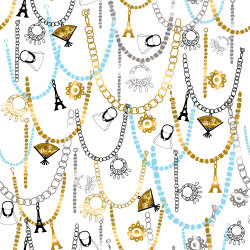 From
glittering miniature designs to Eiffel towers shrunk to its smallest size to
gems and semi-precious stones, charm bracelets say a lot about the people
wearing them. From the name itself, charm bracelets are inherently appealing for
almost everyone. The word “charm” which means to attract, does exactly the very
thing these precious things are intended to do. For some, the way miniature
designs jangle as they dangle with the wearer’s motion is pleasing to hear. For
others, the exquisite designs of intricately made charms attached to the link
are just as beautiful as the outlook of the wearer. From
glittering miniature designs to Eiffel towers shrunk to its smallest size to
gems and semi-precious stones, charm bracelets say a lot about the people
wearing them. From the name itself, charm bracelets are inherently appealing for
almost everyone. The word “charm” which means to attract, does exactly the very
thing these precious things are intended to do. For some, the way miniature
designs jangle as they dangle with the wearer’s motion is pleasing to hear. For
others, the exquisite designs of intricately made charms attached to the link
are just as beautiful as the outlook of the wearer.
No matter how people view these little dangling designs, perhaps the most
attractive thing about charm bracelets is the kind of story they tell about the
wearer. A symbolic piece of jewelry worn on the wrist, it may depict unforgotten
memories of love, aspirations, interests, and many other precious moments one
has experienced throughout life. Mostly worn and loved by women as an expression
of personal style, wearing one is like telling your story to the world.
Proclaiming the owner’s status like her affluence or power, charm bracelets are
an exquisite and shining autobiography held close to the hand of the wearer.
Some charm bracelets are as precious as being part of the family’s heirloom,
passed on by women in the family from one generation to the next. A practice
occurring more commonly between mothers and their daughters.
History of Charm Bracelets
The history of charm bracelets is as old as the prehistoric Neolithic era when
inhabitants of bare lands would pick unusually looking, strangely shaped stones
and wood with the purpose of warding off enemies. Quite different from its use
today, it was used as talisman or as amulets to protect the wearer from the
wrath of bad spirits or attack from the other tribes. Some of the most widely
used materials for creating these embellishments include clay,
rock or
shells found in the surroundings. Wearing them is generally connected to showing
devotion to love, magic and protection by divine powers.
Here are the top three cultures that started to popularize charm bracelets:
1) Egypt
Considered as one of the oldest civilizations, Egypt had been one of the
wealthiest countries of the ancient times. Other than their
grand
monuments like the pyramids that continued to attract tourists yearly,
Egyptians have shown, earlier than other cultures their love for jewelry. The
complex designs made by artisans of this period draw attention from scholars
from around the world.
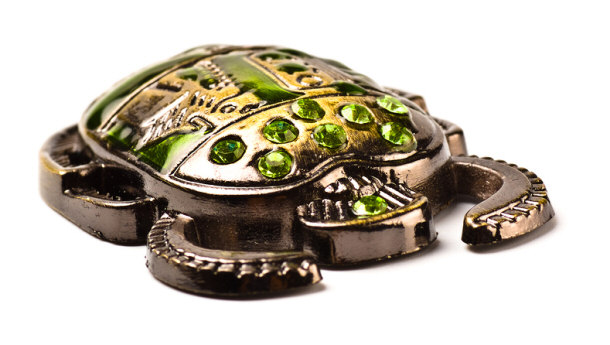
For Egyptians, ownership of precious jewelry made from metals and stones
symbolizes national pride. During the earlier period of the empire, gold was not
widely used as it was scare in the area. Instead, they made use of semi-precious
stones that were abundantly scattered around the kingdom. It was only when Egypt
conquered Nubia, or “The Land of Gold” that this metal became a favorite
material for jewelry making. As the kingdom’s supply of metals increased,
Egyptians of high ranking birth took the shaped metals and forms as a display of
status. For many women, charm bracelets were a favorite with ordinary Egyptians,
wearing ones that are made from glass or brass. The type of metals used and the
intricacy of designs depict the status of the wearer. In addition to the role it
plays in showing one’s social rank, charm bracelets were worn with the belief
that it would ward off evil spirits, bring fertility, protect against diseases,
and that they even attract blessings from gods. The charm bracelets are usually
decorated with scarabs, a creature believed to be the protector of secrets and
the symbol of rebirth. Perfectly different from the practice of the modern
world, charm bracelets made during the ancient Egyptian civilization were not
passed down from generations. Instead, they were buried with the owner as part
of properties they needed when traveling to the underworld.
2) Rome
Another ancient civilization that proved to have led the popularity of charm
bracelets was the Roman Empire. In the past, Romans have been obligated to wear
a type of medallion to signify their citizenship. This means that it served as
the equivalent of the modern day identification card. It was believed that when
one who wears this medallion was found to be victimized by people not belonging
to the empire, it would bring retribution.
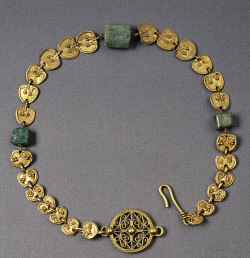 For many Christians, the wearing of fish designed charms under their clothing
depicts their connection to the practice of secret worship ceremonies. This is
because of the fear of publicizing their religious practices. The fish design
was adapted from the Greek word for fish (“ichthys”) that serves as the acronym
for the phrase that goes, “Jesus Christ, Son of God, Savior.” For some families,
lines from the Torah were engraved in the small pieces of charms worn by men and
women. During the Dark Ages, it was even used as a form of identification for
family members. Experts believed that charms were used to signify superstitious
beliefs. For many Christians, the wearing of fish designed charms under their clothing
depicts their connection to the practice of secret worship ceremonies. This is
because of the fear of publicizing their religious practices. The fish design
was adapted from the Greek word for fish (“ichthys”) that serves as the acronym
for the phrase that goes, “Jesus Christ, Son of God, Savior.” For some families,
lines from the Torah were engraved in the small pieces of charms worn by men and
women. During the Dark Ages, it was even used as a form of identification for
family members. Experts believed that charms were used to signify superstitious
beliefs.
What set Italian charms apart from those of Egypt were their specific and
tailored styles that include rectangular or modular shaped metals. Additionally,
they are not used as dangles for a link but were directly linked together to
form a band-like bracelet without any hanging piece. Artisans from Italy were
also the first ones to come up with charm designs that can be linked or unlinked
in order to create different patterns and shapes. Equally important, it also
made adjusting sizes easier for women of different sizes.
3) England
The charm of the bracelets from ancient civilizations conquered the western
world as advocated by the fashion sense of Queen Victoria. In the earlier part
of the 20th century, the Queen of England popularized the use of charms as that
of a small locket with family portraits and a lock of hair from her husband,
Prince Albert. During this time, the queen modeled the use of charm bracelets
made from gold, sterling silver and platinum. For the ordinary English women, a
charm bracelet of glass beads and lockets became a cheaper more affordable
version. It was said that Queen Victoria would wear her charm bracelets with the
lock of Prince Albert’s hair when they are away from each other believing it
would make him come back safely.
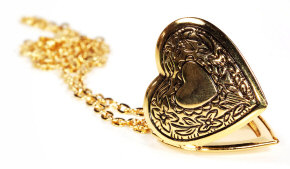 This practice spurred interest among many Europeans and cause them to sport
lockets with locks of hair from their loved ones. By the end of World War II,
charms gained popularity and American soldiers stationed in England or parts of
Europe would send back home lockets with their hair as something their wives,
mothers, or daughters could wear. It was during this time when women started to
accessorize with charm bracelets to express their interests, religion, and
engagement or marriage. With the commercialization of charm bracelets comes its
function symbolizing anniversaries, births, and graduation. In America, plastic
charms were popular among children as it featured designs like Mickey Mouse,
Popeye and other small prominent figures depicting American culture. This practice spurred interest among many Europeans and cause them to sport
lockets with locks of hair from their loved ones. By the end of World War II,
charms gained popularity and American soldiers stationed in England or parts of
Europe would send back home lockets with their hair as something their wives,
mothers, or daughters could wear. It was during this time when women started to
accessorize with charm bracelets to express their interests, religion, and
engagement or marriage. With the commercialization of charm bracelets comes its
function symbolizing anniversaries, births, and graduation. In America, plastic
charms were popular among children as it featured designs like Mickey Mouse,
Popeye and other small prominent figures depicting American culture.
Common Charm Designs and Their Meanings
Like
tattoos, charms on a bracelet also express messages intended to be
communicated by the wearer. The following are the most popular charm designs and
their meanings:
- Angel and Cross: The wearer is asking for blessings, or is expressing
thankfulness for such. Additionally, it represents asking for guidance and
protection from your guardian angel or from God.
-
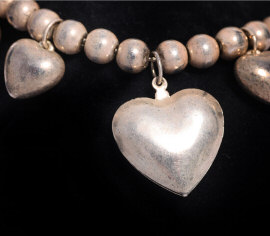 Heart:
The wearer is expecting to find
their true love or has found them. For
some, it means that true love will find them soon. Heart:
The wearer is expecting to find
their true love or has found them. For
some, it means that true love will find them soon.
- Key: The wearer belongs to a happy home or wants to establish one on her
own.
- Flower: The wearer is experiencing a blossoming story of love.
- Airplane/ Car/ Suitcase: The owner wants to live a life full of travels
and adventure that takes her to different places of the world.
- Ballerina: The wearer expresses that she wants her dreams to come true.
Alternately, it means overcoming difficulties to fulfill aspirations.
- Butterfly/Dolphin: The wearer wants to live a colorful and carefree
life, something that will bring joy and fun.
- Cake: The wearer wishes that the sweet life will begin soon.
- Dragonfly: The wearer wants to attract or keep good fortune.
- Elephant: The wearer wants to live a life full of great memories worthy
to be cherished for a lifetime.
- Handbag: The wearer wishes to live a prosperous life.
- High-heeled shoes: The wearer want to have a life that’s glamorous and
in style.
- Lock: the wearer wants to keep loved ones together and for dreams to
unlock soon.
-
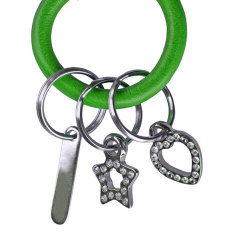 Owl: The wearer wants to live a
life full of wisdom. Owl: The wearer wants to live a
life full of wisdom.
- Postage Stamp: The wearer wants to receive good news.
- Star: The wearer wants to have all wishes granted.
Charming Final Thoughts:
Whether made of
expensive materials like gold or silver, or as heirlooms or decoration,
charm bracelets have enchanted women from different cultures throughout time.
The first artisans designed this intricate piece of jewelry hundreds of years
ago to embellish the looks of the royals and exhibit one’s position in a higher social class. Perhaps, it is from this practice that people
use them to convey messages and personal aspirations. As its name tells us, this
type of bracelet attracts good fortune and good things.
Charm bracelets have two parts. First is the link or chain that can be
wrapped around one’s wrist and the other part, the charms that can either be
permanently attached or can be interchanged or replaced. For many of us, they
are
used as decoration to depict one’s fashion sense, while for others, it conveys
important meanings as depicted by the designs and shapes of charms.
The purpose of charm bracelets has changed so much over time. In the present, they are
known to attract good luck. In older times, they served as amulets or talismans
that brought protection to the wearer by containing spells and blessings. For
many young women of today, charm bracelets are for decorations, but for those
from the ancient times, they were used to identify one’s power, religious belief
and identity in society. No matter how people differ in their views on charm
bracelets, it is sure that this intricately designed piece of jewelry will
continue to allure many more people in the future.
Jewelry
15 Remarkable Facts About Diamonds
Charm Bracelets: Origin and Design Meanings
Jewelry Through the Ages
|